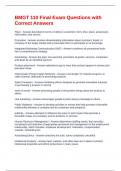BMGT 110 Final Exam Questions with
Correct Answers
Place - Answer-described in terms of utility to customers: form, time, place, possession,
information, and service
Promotion - Answer-involves disseminating information about a product, brand, or
company to the target market and to persuade them to participate in an exchange
Integrated Marketing Communication (IMC) - Answer-combines all promotional tools
into a comprehensive strategy.
Advertising - Answer-the paid, non-personal, promotion of goods, services, companies
and ideas by an identified sponsor.
Product placement - Answer-advertisers pay to have their product appear in movies and
television show.
Infomercials/ Product Sales Networks - Answer-a full length TV network program, or
cable channel, dedicated to promoting products
Sales Promotion - Answer-marketing efforts designed to generate immediate interests
in purchasing a product or service
word of mouth - Answer-promoting people to tell positive things about the product to
others
viral marketing - Answer-encourages people to pass along a message to others
Public Relations - Answer-to develop activities or events that help promote a favorable
relationship between a company and its customers and prospects
publicity - Answer-attempts to influence the press to print stories that promote a
favorable image of a company and its products or services
Human Resource Management - Answer-determines staffing needs, then provides
recruitment and selection of appropriate personnel and management of the employment
relationship, which includes: employee development, motivation, compensation,
rewards, scheduling,etc.
Advertising Ethics - Answer-stretches the truth, some completely untruthful.
Intellectual Property - Answer-laws, patents, and other laws are in place to protect
intellectual properties and afford protections in many cases
,Competition issues - Answer-rooted in the channel of distribution. Used to create
service efficiencies, a channel of distribution is a network of intermediaries that includes
wholesalers, distributers, retailers, etc.
Product Related Challenges - Answer-Even if a company is committed to sound ethical
practices the nature of the product and the methods used to distribute and sell the
product can open the doors to a host of potentially damaging liabilities including legal
battles and stiff fines
Product Safety - Answer-responsibility of product
Frederick Taylor - Answer-Scientific Management studied the most efficient way to
perform any task. Time-motivation and principle of economy studies.
Hawthorne Studies - Answer-workers felt more motivated when they were bing studied.
Maslow's Hierarchy of Needs - Answer-each need on the pyramid motivates in a
different way. Physical, safety, relational, ethical, self-actualization
Herzberg's Motivation Factors - Answer-Hygiene factors are points of dissatisfaction but
do not motivate your actions
Theory x - Answer-the belief that employees do not really want to work and that it is
their job to structure work and energize the employee
Theory Y - Answer-management believes that most people will want to do well at work
and that there is a pool of unused creativity in the workforce
Theory Z - Answer-a blend of American-Japanese management styles, is more flexible
and holistic
Goal-setting theory - Answer-Developed by Peter Drucker, focuses on motivating with
ambitious buy achievable goals.
Expectancy Theory - Answer-Victor Vroom, recognizes that people will assess any
given goal/task and determine its possible outcomes to the associated rewards
Reinforcement Theory - Answer-employees are motivated by positive and negative
reinforcement of behaviors
Equity Theory - Answer-people mentally calculate the differences between themselves
and other workers
Strike - Answer-workers refuse to go to work and generally picket their employer
, boycott - Answer-pressure management by asking consumers not to buy the products
of the company
Finance - Answer-analyzes and plans a firm's credit, cash flow, investments, and
expenditures, and then determines future paths.
Accounting - Answer-fundamental method for developing and maintaining business
information.
Bookkeeping - Answer-the recording of business transactions
Journal - Answer-where accounting data is first entered
General Ledger - Answer-specialized book where data is categorized and made
available.
Assets - Answer-everything a company owns that is due to it including current assets,
fixed assets, and intangible assets
Liabilities - Answer-all the claims against a corporation. Includes debts, salaries,
dividends, accounts payable, taxes payables, etc.
Owners Equity - Answer-the value that accrues to the owners
Balance Sheet - Answer-provides a quantitive summary of a company's financial
condition at a specific point in time, often at the end of the month.
Revenues - Answer-the earnings of a firm before subtracting costs
Cost of Goods Sold - Answer-the costs of materials and resources to make a product
Gross Profit - Answer-amount made on sales after cost of goods
Operating Expenses - Answer-costs involved in operating the business
Net income - Answer-amount remaining after all expenses have been deducted.
Statement of Cash Flows - Answer-reports the inflows and outflows of cash relating to
operations, investments, and financing for a particular period of time
Financial management - Answer-analyzes accounting data to develop and recommend
strategies, budgets, cash flow, forecasts, etc. which will improve the financial strength of
the firm
Forecasting - Answer-analyzes and predicts financial events in a period of one year or
less and is the foundation for all other forecasts




